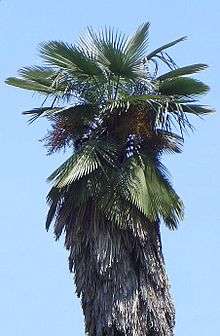Trachycarpus takil
| Trachycarpus takil | |
|---|---|
 | |
| Scientific classification | |
| Kingdom: | Plantae |
| (unranked): | Angiosperms |
| (unranked): | Monocots |
| (unranked): | Commelinids |
| Order: | Arecales |
| Family: | Arecaceae |
| Genus: | Trachycarpus |
| Species: | T. takil |
| Binomial name | |
| Trachycarpus takil Becc. | |
Trachycarpus takil, with the common name Kumaon palm, is a fan palm tree that is endemic to the foothills of the Himalaya in southern Asia. [1]
Distribution
The palm "tree" is native to the Kumaon division of Uttarakhand Province in northwestern India, and into adjacent western Nepal. [2] [3] [4] The palm grows at altitudes of 1,800–2,700 metres (5,900–8,900 ft)[1] and it receives snow and frost on a regular bases in its native habitat.[5]
Description
Trachycarpus tail grows to 10–15 metres (33–49 ft) tall, with a rough trunk covered in partial fiber from the old leaf bases as it sheds its fronds naturally leaving only a smal part of the leaf bases on the trunk which also disappear in time. [6]
It is one of the cold hardiest palms to produce a tall trunk, tolerating temperatures from −14 °C to −20 °C possibly more(No Official Studies Have Been Made), possible leaf damages or total defoliation due to extreme temperatures is a possibility. [7]
It is easily distinguishable from Trachycarpus fortunei from its infancy by:
- the young plants having the tendency to growing obliquely.
- the young trunk being distinctly conical
- the adult trunk covered with very tightly clasping (not ruffled) chestnut brown fibers.
- the short, triangular, erect ligulas on the leaf sheaths of the terminal shoot.
- the leaves more spreading and those of the previous year being placed just below the last flowering spadices, reflexed, although still alive, by the leaf blade being irregularly divided only down to about the middle.
- the fruit being more distinctly uniform or considerably broader than high.
- the first leaves of sprouting T. takil seeds are duplicate (having only two ridges differing from T. fortunei with its quadruplicate first leaves.)
Taxonomy
Trachycarpus takil was first discovered by a Major Madden, a British Army colonel with a passion for botany stationed in the Himalayas during the 1840s. Unfortunately, while Madden produced precise descriptions of both the plant and location, he made the fatal mistake of assuming it to be Trachycarpus martianus, failing to realize it was a separate species, thus losing the chance to claim its discovery.
First officially described by the Italian Botanist Odoardo Beccari in 1905 ("Le Palme del Genere Trachycarpus", in Webbia I). The leaves naturally shed them selfes unlike Trachycarpus fortunei , leaving a semi bare trunk covered in fiber from the old leaf bases. Petioles about as long as the blade. Blade 3/4 orbicular, 1–1.2 m in diameter, irregularly divided down to about the middle into 45–50 segments, 60-85 cm in length from the top of the petiole (hastula) to the apex of the median segments, the latter stiff and erect, not with drooping tips. [8]
Cultivation
Trachycarpus tail is cultivated as an ornamental "tree", including use as a cold hardy outdoor palm in colder climates than most palms could survive in. [7]
The greatest reported cold tolerance is −27.5 °C (−17.5 °F) by four specimens in Plovdiv, Bulgaria during a severe cold spell on January 6, 1993, and placing it in USDA Zone 5; and after researching this reference all characteristics point to this palm being of the species Trachycarpus Takil and therefore moved from Trachycarpus Fortunei to here. [9]
Some plants in cultivation in the United States under the name Trachycarpus takil may be misnamed specimens of the dwarf form of Trachycarpus fortunei, also known as Trachycarpus wagnerianus.
See also
| Wikimedia Commons has media related to Trachycarpus takil. |
References
- 1 2 PACSOA: Trachycarpus takil
- ↑ Kulkarni, A. R. & Mulani, R. M. (2004). "Indigenous palms of India". Current Science (India) 86 (12): 1598-1603. Available online (pdf file).
- ↑ Flora of Nepal: Trachycarpus takil
- ↑ Husain, T., & Garg, A. (2004). Trachycarpus takil (Becc.) is not a 'rare' palm. Current Science (India) 86 (5): 633-634. Available online (pdf file).
- ↑ http://www.palmpedia.net/wiki/Trachycarpus_takil
- ↑ http://www.palmpedia.net/wiki/Trachycarpus_takil
- 1 2 Trebrown.com: Palm hardiness trial
- ↑ Beccari, O. 1931: Asiatic palms: Corypheae. Ann.Royal Bot. Gard. 13, Calcutta.
- ↑ Polar Palms: The Polar Palms of Bulgaria